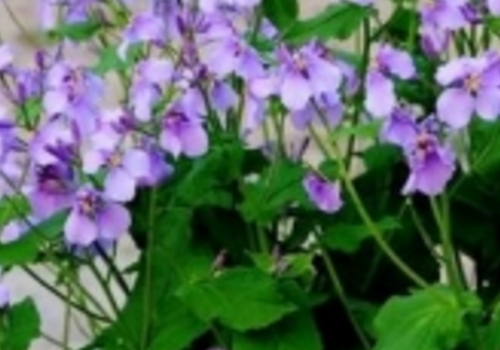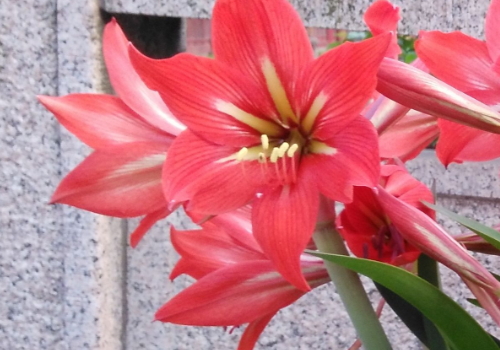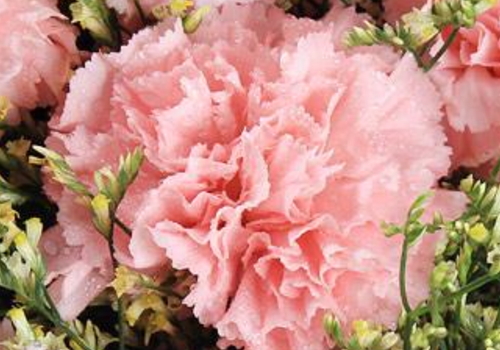What is the flower language of February orchid? when will it be sown?
February orchid, is very beautiful, a lot of people want to plant. What is the fancy language of February Orchid? When will the seeds be sown?
What is the floral language of February Orchid:
Take care of yourself and open up quietly. When the flowers bloom into the sea, they tend to reach the sky. At that time, they are still in full bloom, and the curtain call comes to a close until the spring dusk. The late Mr. Ji Xianlin praised February orchids like this in February: "when they should open, they will open; when they should disappear, they will disappear." They are in the midst of great waves, letting nature take its course, and they don't care about sorrow or joy. "
Yes, February orchid is like this, conforming to nature, low-key and simple. Therefore, the flower language of February Orchid is: humility and simplicity, selfless dedication.

When will the orchid sow?
1. Sowing time
The most common way to get February orchid is to sow seeds, which are very resistant to drought and cold, and sowing is very simple. It is usually sown from August to September every year, and it can blossom at the end of spring after a long winter.
2. Sowing method
First of all, prepare the potted soil and choose a medium-deep and wide flowerpot as far as possible, so that the effect is better. Put a mixture of garden soil, perlite and plant ash in the flowerpot and add a small amount of base fertilizer.
Sow the prepared seeds evenly in the basin, cover with a thin layer of soil, water thoroughly, cover the flowerpot with glass or film, ensure a certain temperature and humidity, normal management can. Replenish the sun in time when the seedlings grow.
All right, this is the end of the introduction of Orchid language in February, all of you understand.
Orchid planting in February, orchid language in February, orchid blooming in February, when to sow orchid in February, how to eat orchid in February (February blue), Cruciferae, annual or biennial herbs. It is called February Blue because the blue-purple flowers begin to bloom around the second month of the lunar calendar. Grow in plains, mountains, roadsides, the edge of the ground. Low requirements for soil light and other conditions, cold and drought resistance, tenacious vitality. February orchid planting
1. Soil: February orchid is not strict with soil. It is best to choose sandy soil that is loose, fertile and well drained. Potted February orchid has higher requirements for basin soil. Here, it can be considered to choose 6 parts of garden soil, 2 parts of perlite and 1 part of plant ash to mix evenly, and the base fertilizer in the basin should be enough.
2. Lighting: as February orchid is a short-day plant, daily sunshine does not need too long, indoor light can be illuminated by scattered light.
3. Temperature: due to the cold resistance of February orchid, the temperature control can be extensive, and the most suitable temperature for growth and flowering is between 15 and 25 degrees.
4. Fertilization: orchid likes fertilizer in February. Sufficient fertility will not only make February orchid grow faster, but also promote the flowering and fruiting of February orchid to fertilize four times a year. Flower bud fertilizer in early spring, strong fertilizer after flower fade, strong fruit fertilizer after fruit setting, strong seedling fertilizer before winter. If 0.2% potassium dihydrogen phosphate solution is sprayed once at the flower bud stage and the young fruit stage, the flower color will be more beautiful and the fruit will be fuller.
5. Insect diseases: the common pests in February orchid planting are aphids, cabbage insects, snails, leaf miners and so on. If pests are found, drug control should be carried out in time.
6. Pruning: in order to maintain a good ornamental effect of February orchid, it must be controlled not to make it sturdy, and it is generally trimmed to a height of 10 ~ 15 cm with a lawn mower during the fruiting period.
Orchid language in February
The flower words of Yuelan: humility and simplicity, selfless dedication. It is an annual or biennial herb. It is called February orchid because it begins to bloom blue-purple flowers around the second month of the lunar calendar. It is also because it is said that Zhuge Liang used to pick tender shoots as dishes when he led the army to battle, so he got the name Zhuge vegetable.
Legends related to February Orchid
According to legend, Zhuge Liang became Liu Bei's military commander, director of military food and taxes. As Liu Bei has a large number of troops and horses, the relative demand for food and forage is greater, and the burden on the people is even greater. For example, if the people do not have enough to eat and wear, the people will be unstable. On one occasion, Zhuge Liang went on a micro-clothing tour and saw a dish called "Mangjing". She learned from the old farmer that this dish was full of treasures, leaves and stems could be eaten, and leftovers could be made into pickles. When it was not picked up, it could become the head dish.
Zhuge Liang was very interested in this dish. He asked the old farmer about the yield and planting method of "Mengjing" per mu, and ordered soldiers to open up wasteland to grow this vegetable. On the one hand, it could be used as livestock feed, which was both economical and affordable, and killed two birds with one stone. So Zhuge Liang ordered the local army to plant "Mangjing" widely, and the military grain was sufficient. Later generations called this dish Zhuge vegetable.
Orchid florescence in February
February orchid blossoms from April to May and the fruit period is from May to June.
In February, the plant height of Cymbidium is 20-70cm, usually 30-50cm. The stem is erect and has only a single stem. The basal and lower cauline leaves are pinnately parted, the leaf base is heart-shaped, and the leaf margin has obtuse teeth; the upper cauline leaf is oblong or narrowly ovate, the leaf base clasping is auriculate, and the leaf margin has an irregular serrated structure. Racemes terminal, bearing 5-20 flowers, petals with fine veins, flowers are mostly blue-purple or light red, with the extension of flowering, the color gradually fades, and finally becomes white. The florescence is from April to May and the fruiting period is from May to June. Petals 4, long ovate, with long claws, claws about 3-6mm, petal length about 1-2cm; stamens 6, filaments white, anthers yellow; calyx slender and tube-shaped, blue-purple in color, sepal length about 3mm. The fruit is cylindrical and 6-9cm long. The top of the pod has a slender beak. The fruit has four edges and contains a large number of small dark brown seeds. The seeds are ovate to oblong. When the fruit is ripe, it will crack naturally and the seeds will pop out.
When will the orchid sow?
Some fresh seeds just harvested have the physiological phenomenon of post-ripening, the germination rate of early sowing is low, and the germination lasts for 1 ~ 2 months or even longer. The stored seeds have passed dormancy, and February orchid can be planted directly. The sowing time can be in summer or autumn, but August to September is the most suitable. The sowing rate is 2 kg per square meter, and if spray sowing is adopted, the sowing rate should be increased by 15% to 20%, with 300 seeds per gram. The February orchid florescence begins from February to March every year and can last until June of that year, during which the flowers continue to bloom and the fruits mature from May to June. After the orchid is planted and mature, the fruit will pop open automatically and spread the seeds widely. The cultivation and management of February orchid is relatively simple, which should be watered in time and fertilized for 1 to 2 times.
How to eat orchid in February?
1. Wild vegetables can be salad in February.
Wild vegetable February orchid can be eaten later in cold salad. in cold salad, you need to soak the collected wild vegetable February orchid in clean water for 15 minutes, wash it out, put it into a blanch, fish out the cold water, and cut it into segments. Add seasonings such as salt, vinegar and sesame oil to mix evenly, and friends who like garlic can also add an appropriate amount of garlic paste.
2. Wild vegetables can be stuffed with orchid.
Making wild vegetable February orchid as stuffing is also a good way to eat. You can blanch fresh February orchid with boiling water, chop it up with beef or mutton after removing water, add light soy sauce, salt, sesame oil and five-spice powder, and make it into stuffing. It's a good choice to make steamed buns or dumplings.
3. Wild vegetables can be fried in February orchid
Wild vegetable February orchid fried food is a very common way to eat, but it needs to be soaked in clean water to avoid some harmful ingredients, soaked and washed, cut into segments, according to their own taste needs, directly fried into a variety of dishes.
Related encyclopedia
Tourmaline mattress Christmas decoration album splash ink landscape painting abstract paper rattan warp knitted cloth wheat straw painting crystal flower Alxa agate water warm blanket blue porcelain gold toad bed products Ming Dynasty blue porcelain Jingdezhen blue and white porcelain Song Dynasty GE kiln porcelain crystal vase Shu embroidered love mattress
The Flower language and Legend of Eryuelan
The Flower language of February Orchid
The flower language of February Orchid is modest and simple, selfless dedication.
As its flower language, beautiful appearance, flowers blooming into the sea, but still protect this nature, do not forget the original ideal and ambition. Perhaps it is because spring blossoms, the purple light enriches the whole spring, and when summer comes, life begins again. Some people say that February orchid is very great, not only blooming beautiful, but also glowing through its own nutritional value.
The legend of the orchid in February
This legend is about another name of February Orchid-Zhuge vegetable. Zhuge "Wolong", entrusted with an important task, assisted the master and sent troops to defeat Wei.
Legend has it that Zhuge Liang became Liu Bei's military servant, in charge of military food and taxes. Because Liu Bei has thousands of troops, the demand for food and forage is relatively large, and the burden on the people is also relatively heavy. The people do not have enough to eat and wear, and people are in a state of panic. Once again, when Zhuge Liang went on a secret visit, he saw a kind of wild vegetable called "Mangjing". He learned from the old farmer that this vegetable is full of treasures, leaves and stems can be eaten, and leftovers can be made into pickles. When it is not picked up, it can become the head dish.
Zhuge Liang was very interested in this dish. he asked the old farmer about the method of growing "Mengjing" and ordered his officers and soldiers to plant widely in the army, which could be used as a supplement to military food on the one hand and as feed for livestock on the other. Since then, military food has been sufficient, and the pressure on the people has been alleviated a lot. The vegetables planted by Zhuge Liang were called Zhuge vegetables by later generations.
- Prev

What is the red flower language of Zhu Dinghong? how to reproduce?
Zhu Dinghong, this is a common plant, but many people don't know its name. What is the red flower language of Zhu Ding Hong? How do you breed? What is Zhu Dinghong flower language: Zhu Dinghong is a relatively fragile bulb plant. Growing Zhu Dinghong in Britain must be covered with a protective cover against cold damage, and the sunshine should be adequate.
- Next

How can carnations blossom several times a year?
Carnations are very beautiful, and many people are planting them. How many times a year can carnations bloom? How do you raise it in water? Carnations can bloom several times a year: carnations are perennial herbs, one plant and one flower, and the flowering period is from April to September. If cultivated in a protected area, it can blossom all the year round.
Related
- Fuxing push coffee new agricultural production and marketing class: lack of small-scale processing plants
- Jujube rice field leisure farm deep ploughing Yilan for five years to create a space for organic food and play
- Nongyu Farm-A trial of organic papaya for brave women with advanced technology
- Four points for attention in the prevention and control of diseases and insect pests of edible fungi
- How to add nutrient solution to Edible Fungi
- Is there any good way to control edible fungus mites?
- Open Inoculation Technology of Edible Fungi
- Is there any clever way to use fertilizer for edible fungus in winter?
- What agents are used to kill the pathogens of edible fungi in the mushroom shed?
- Rapid drying of Edible Fungi

